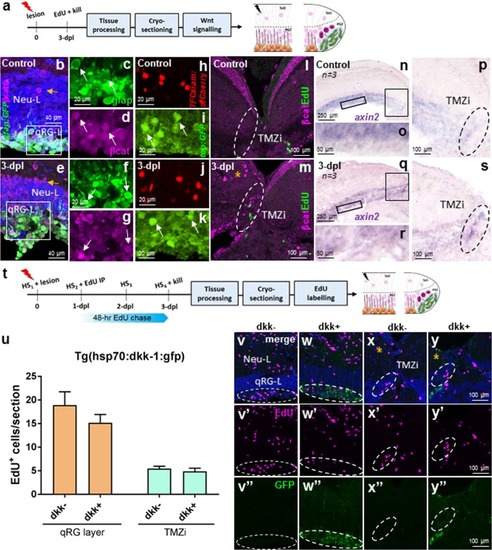
Wnt/β-catenin signalling in stem cell zone 1 (qRG-L) and zone 2 (TMZi) following tectal lesion. (a) Experimental design to study Wnt/β-catenin signalling at 3-dpl. (b–d) Physiological levels of β-catenin expression in the neural layer (Neu-L) and qRG layer (qRG-L; stem cell zone 1). A small number of β-catenin-positive neuronal cell bodies are seen in the Neu-L (yellow arrow). White box depicts higher magnification images of the qRG-L in (c,d). Split-channel images showing co-labelling of qRG (c) and β-catenin (d; white arrows). (e–g) Lesion-induced β-catenin staining in the neural layer (Neu-L) and qRG layer (qRG-L) showing upregulation in the proportion of neuronal cells expressing nuclear β-catenin. White box depicts higher magnification images of the qRG-L in (f,g). Split-channel images showing co-labelling of qRG (f) and β-catenin (g; white arrow). (h–k) Common expression pattern of Wnt activity observed in the qRG-L between control (h,i) and at 3-dpl (j,k) using the Wnt reporter lines Tg(TCFSiam:mCherry) and Tg(top:GFP; white arrows). (l,m) β-catenin expression and EdU-labelling at the TMZi (stem cell zone 2; dashed white circles) under control conditions (l) and at 3-dpl (m, orange asterisk), showing increased nuclear expression in putative neurons post-lesion. (n–p) Homeostatic levels of axin2 expression in the qRG layer (o) and TMZi (p; black dashed circle). Black boxes in (n) denote higher magnifications in (o,p). (q,s)axin2 expression 3-dpl in the qRG layer (r) and TMZi (s; black dashed circle). Black boxes in (q) denote higher magnifications in (r,s). (t) Experimental design to study the requirement of Wnt/β-catenin signalling for the proliferative response of stem cells to tectal stab lesion using the heat-shock line Tg(hsp70l:dkk-1:gfp). (u) EdU population size in the qRG layer and TMZi shows no change in proliferation post-injury in the absence of Wnt signalling (dkk+) compared with wildtype animals (dkk-) using the Tg(hsp70:dkk-1:gfp) transgenic line (unpaired t-test, two-tailed: qRG layer, p = 0.3081; NE-Ap zone, p = 0.4960). (v-w”) Representative images of EdU+ staining (pink) in the qRG layer (dashed lines) in dkk- (control; v-v”) and dkk + (w-w”) post-lesion. (x-y”) Representative images of EdU+ staining (pink) in the TMZi (dashed lines) in dkk- (control; x-x”) and dkk + (y-y”) post-lesion. Orange asterisk denotes the lesioned hemisphere. Note GFP+ expression observed in the dkk + (w”,y”) but not dkk- (v”,x”). Experimental replicates were combined for all statistical analyses. All data presented are mean ± S.E.M. Significance was accepted at *p < 0.05. In panels b,e, v–y, DAPI nuclear counterstaining (blue) was performed. In all cross-sectional images dorsal is oriented up. TMZi, internal tectal marginal zone; dpl, days post lesion.
|

